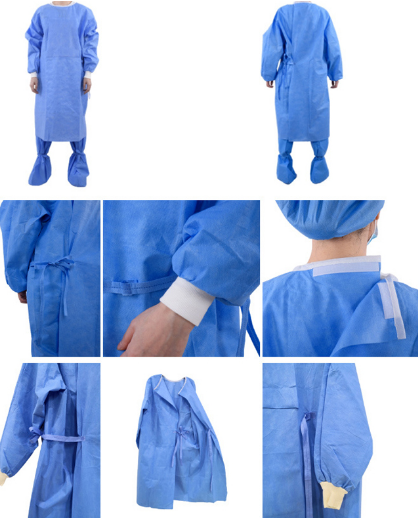Disposable medical isolation gowns are specialized garments designed to create a barrier between healthcare professionals and potentially infectious materials. These gowns are crucial in environments where the risk of exposure to pathogens, bodily fluids, and other contaminants is high, such as hospitals, clinics, laboratories, and isolation units. They serve as a protective shield, reducing the transmission of infections from patients to healthcare workers and vice versa.

Key Features and Components
Disposable surgical gowns are engineered with a range of features to ensure optimal protection and comfort:
1. Barrier Material: These gowns are crafted from non-woven fabrics that provide a strong and effective barrier against liquids, microorganisms, and other potentially harmful substances. The material is selected for its ability to resist penetration and maintain its integrity under various conditions.
2. Full Coverage: Isolation gowns offer full coverage, typically extending from the neck to the knees or ankles. This coverage ensures that the wearer's clothing and body are shielded from potential contaminants.
3. Closures: Gowns feature secure closures, such as ties or adhesive strips, to prevent gaps or openings that might expose the wearer's skin. This ensures a snug fit that reduces the risk of contamination.
4. Thumb Loops: Some gowns are equipped with thumb loops, which secure the sleeves in place and prevent them from riding up during movements, ensuring continuous protection.
5. Resistance to Fluids: Isolation gowns are designed to repel liquids, including blood, bodily fluids, and other potentially infectious substances. This characteristic prevents the absorption of liquids and minimizes the risk of cross-contamination.
6. Breathability: Despite their impermeability to liquids, disposable medical isolation gowns are engineered to be breathable, ensuring comfort for healthcare professionals who may need to wear them for extended periods.
7. Disposable Design: The disposable nature of these gowns is a key feature. After each use, the gown is safely discarded, preventing the potential spread of contaminants to other areas or patients.
Importance in Healthcare Settings
Disposable medical isolation gowns play a vital role in healthcare environments:
Infection Prevention: The primary purpose of these gowns is to prevent the transmission of infections between healthcare professionals and patients. They act as a barrier against pathogens that could be present on the patient's body or surfaces.
Cross-Contamination Mitigation: By using disposable gowns, the risk of cross-contamination is significantly reduced. Healthcare workers can change gowns between patient interactions, minimizing the spread of potential contaminants.
Patient Safety: Isolation gowns not only protect healthcare workers but also ensure the safety of vulnerable patients, especially those with compromised immune systems.
Infection Control Protocols: Disposable medical clothing align with infection control protocols in healthcare facilities. They are an essential component of comprehensive strategies aimed at reducing healthcare-associated infections.
Versatility: These gowns find utility in various healthcare scenarios, including surgeries, patient care, diagnostic procedures, and emergency response situations.
Conclusion
Disposable medical isolation gowns stand as a testament to the healthcare industry's commitment to safety and infection prevention. By providing a reliable barrier against pathogens and contaminants, these gowns enhance the protection of healthcare professionals, patients, and the overall healthcare environment. As medical science advances and infection control practices evolve, disposable isolation gowns remain a critical tool in safeguarding the well-being of all stakeholders in the healthcare ecosystem.





Comments
0